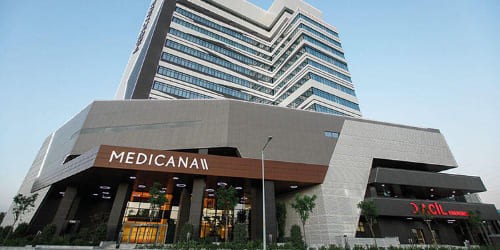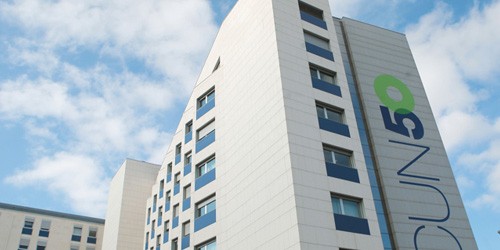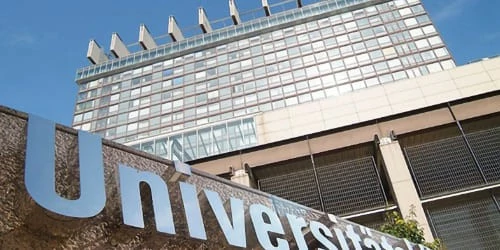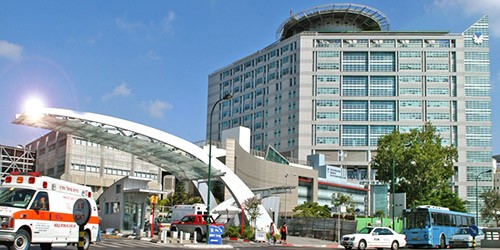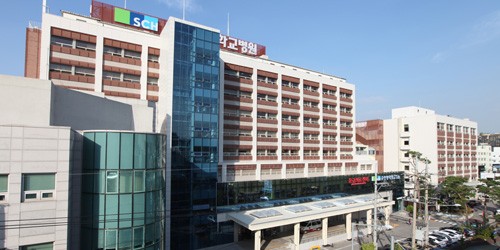Testicular cancer occurs in 1-2 men per 100,000. The disease is most common in men aged 15-44. Europeans and Americans, men with testicular neoplasia and HIV-positive are more susceptible to this type of cancer. Treatment of testicular cancer depends on the stage of the disease. In most cases, it can be treated successfully. You can read more about how testicular cancer is treated abroad in our article.
Listen to the article:
Types and stages of testicular cancer
Testicular cancer is divided into seminomas and nonseminomas, depending on where the tumour originates. The treatment plan for the disease will differ depending on the type of cancer, but in all cases, surgical removal of the tumour is the main approach.
The stage of testicular cancer is determined by the size and location of the tumour, the presence of metastases and the level of cancer markers. The international classification classifies the stages of the disease is, as follows:
Stage 0 testicular cancer (in situ);
Stage 1 testicular cancer;
Stage 2 testicular cancer;
Stage 3 testicular cancer.
Rare forms of testicular cancer include tumours formed from Sertoli and Leydig cells. These are difficult to treat with chemotherapy and radiotherapy and require more aggressive treatment.
Testicular tumours are divided into 3 groups, depending on the prognosis of treatment: good, intermediate and poor. Up to 90% of seminoma cases fall into the good prognosis group.
Treatment for stage 0 testicular cancer
Stage 0 (in situ) testicular cancer is localised inside the seminal tubules, does not affect the lymph nodes and does not cause elevated levels of the HCG and AFP cancer markers.
The most common treatment plan for a stage 0 testicular tumour is observation. For several months, doctors perform regular tests – ultrasound, physical examination and analysis of cancer markers. If the mass is not growing, treatment may not be necessary.
If the tumour in situ shows a tendency to grow malignantly, it is removed by surgery or radiation therapy.
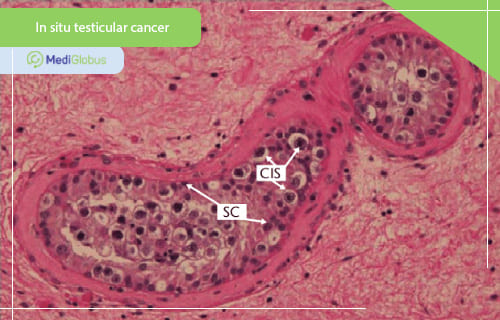
MAKE AN APPOINTMENT FOR A CONSULTATION
A second medical opinion is an opportunity to consult with an experienced international oncologist, to clarify the diagnosis and treatment plan. These meetings can be online or in person. To arrange a free appointment with MediGlobus to meet with an expert, click on the button below and fill out the form.
Treatment of testicular cancer stage 1
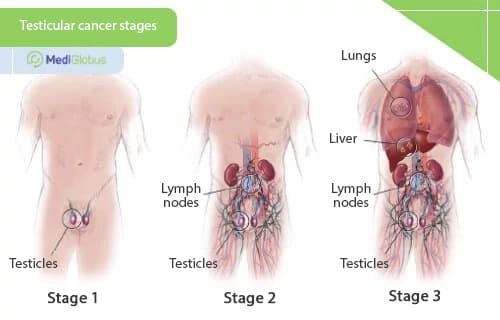
In stage 1 testicular cancer, the tumour is localised inside the organ or has spread to nearby tissues without affecting blood vessels or lymph nodes.
The main treatment for stage 1 testicular cancer is a radical inguinal orchiectomy. Through an incision in the groin, the surgeon removes the tumour along with the testicle and the spermatic cord. The blood and lymph vessels are tied off to prevent a recurrence of the disease.
To maintain symmetry in the scrotum, some patients are fitted with a testicular prosthesis filled with saline.
If the surgeon removes only one testicle, the man does not lose his sexual function or his ability to have a baby. Treatment for bilateral testicular cancer leads to infertility, so patients are usually offered sperm freezing to leave the possibility of IVF in the future. Such men will also need to take testosterone to compensate for the lack of its production throughout life.
Most patients with stage 1 seminoma after successful surgery remain in the oncologist’s care for the next 10 years. They will need a CT scan or X-ray every 3-6 months. Over time, the frequency is reduced to once a year.
Some men may be prescribed 2-3 weeks of radiotherapy or 1-2 cycles of chemotherapy after surgery. Chemotherapy is preferred because patients tolerate it more easily.
For non-seminoma of the testis, surgery is most often accompanied by follow-up with an oncologist, who must be seen every two months for a year, and chemotherapy. Depending on the stage, 1A or 1B, doctors prescribe different protocols. The highest effectiveness is shown by taking several drugs at the same time. In addition, some patients may be recommended to have the lymph nodes in the back of the abdomen removed.
Treatment of testicular cancer stage 2
Stage 2 testicular cancer is divided into sub-stages 2A, 2B and 2C. The main characteristic of the disease is the spread of cancer to the nearby lymph nodes.
For stage 2 testicular cancer, retroperitoneal lymph node dissection (RPLND) is performed. It removes the lymph nodes around the aorta and inferior vena cava at the back of the abdomen. The surgery can be performed at the same time as an orchiectomy or sometime afterwards. The procedure takes 3,5-5 hours and requires a high level of training on the part of the surgeon.
Foreign clinics use the laparoscopic version of lymph node dissection. In this case, the surgeon does not make any large incisions. The manipulation is done through small holes on the surface of the abdomen, through which the doctor inserts instruments. Patients recover much faster from laparoscopic surgery than from a standard open procedure. They can walk and eat normally sooner and experience less pain.
Experienced surgeons perform lymph node dissection with preservation of the nerves. This is a complex surgical technique that reduces the risk of ejaculation problems. Experienced cancer centres offer this option.
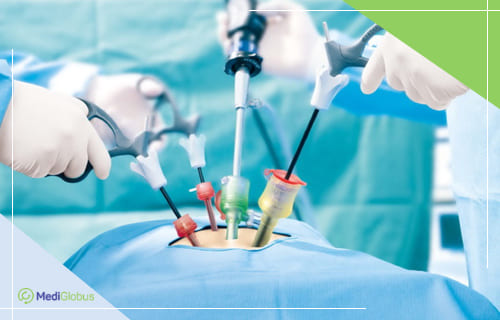
Doctors prescribe 3 or 4 courses of combination chemotherapy after surgery. Some patients with stage 2B seminoma may also benefit from radiotherapy if they do not have enlarged lymph nodes.
Treatment of testicular cancer stage 3
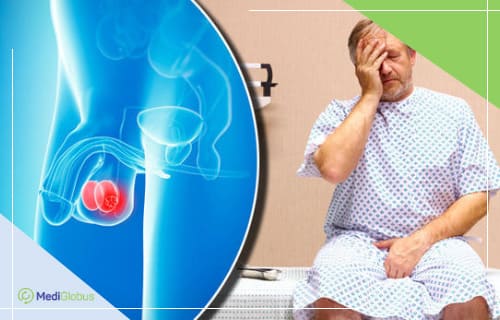
Usually, at stage 3, cancer has spread beyond the borders of the testis. Despite this, in most cases, the disease can be successfully treated.
Stage III seminomas and nonseminomas are treated by radical inguinal orchiectomy followed by 3-4 courses of combination chemotherapy. If there is reason to believe the cancer might be testicular choriocarcinoma, chemotherapy can be started without a biopsy or surgery.
Testicular cancer metastases are most commonly found in distant lymph nodes, liver, lungs, and bones, and less frequently in the brain. Treatment options include surgery, radiation therapy and chemotherapy.
Quite often, metastatic masses are found after chemotherapy or radiotherapy has ended. There is less than a 10% chance that they contain cancer. The main options for treating them are active surveillance or surgery. Such surgery is often very difficult because of the “scarring” that makes it difficult to remove the mass. This is unique to seminoma. Many oncologists recommend active surveillance if the mass is smaller than 3cm, and surgery for masses of 3cm or larger.
If the cancer is resistant to chemotherapy or has spread to several organs, normal doses of chemotherapy may not be enough. The doctor may recommend high-dose chemotherapy followed by a bone marrow transplant.
CHOOSE A CLINIC FOR CANCER TREATMENT
MediGlobus can help you find a testicular cancer treatment clinic, free of charge. We will recommend the best option based on the procedures you should undergo and your budget. Leave your phone number on our website by clicking the button below and we will call you back within one hour.
What should you do if you have relapsed testicular cancer?
Recurrence of testicular cancer usually occurs within the first 2 years after treatment. In 90% of patients, cancer never returns. If two courses of chemotherapy are given after lymph node dissection, the risk of recurrence drops to 1%.
Management of recurrent tumours depends on the initial treatment protocol and the site of cancer recurrence. Tumours of the retroperitoneal lymph nodes are removed surgically. Depending on the results of the surgery, follow-up chemotherapy may be recommended.
If cancer has returned in several retroperitoneal lymph nodes or elsewhere, chemotherapy is usually recommended, followed by surgery.
Relapsed testicular cancer is usually harder to treat, so doctors may recommend undergoing aggressive chemotherapy with a bone marrow transplant.
What is the prognosis for patients with testicular cancer?
| Stage of the disease | Five-year survival rate |
|---|---|
| Stage 0 | 99,2% |
| Stage 1 | 99% |
| Stage of the disease | Five-year survival rate |
|---|---|
| Stage 2 | 96% |
| Stage 3 | 73% |
Where to go for treatment for testicular cancer?
Summary
Testicular cancer is the most common cancer in men aged 25-49. The disease has a good treatment prognosis at all stages, with 95% of patients being completely cured of the disease.
For stage 0 testicular cancer doctors use surgery radiation therapy, or leave the patient under active surveillance.
For stage 1 testicular cancer, radical inguinal orchiectomy is the mainstay of treatment. This can be supplemented by radiation therapy or, more often, chemotherapy.
For stage 2 testicular cancer, subperitoneal lymph node dissection is carried out in addition to orchiectomy. Laparoscopic and nerve-preserving procedures are available in international clinics. Combination chemotherapy is an important part of the treatment.
In stage 3 testicular cancer, treatment is supplemented by the removal of metastases. The patient may need high doses of chemotherapy followed by a brain transplant.
Recurrence of testicular cancer occurs in 10% of cases. More aggressive oncotherapy protocols are used.
Leading oncology centres specialising in the treatment of testicular cancer include Medikana Ataşehir and Liv Vadistanbul (Turkey), Uniclinica Navarra (Spain), Uniclinica Cologne (Germany), Ichilov Medical Centre (Israel), and SoonChunHyang Hospital (South Korea).
Sources:
- 1. American Association of Oncologists on testicular cancer
- 2. World Cancer Research Journal: Testicular Cancer in the World
- 3. National Cancer Institute about testicular cancer
To sign up for testicular cancer treatment abroad, click on the button below and fill in the form. Our coordinators will call you back within 30 minutes. They will provide all the necessary information and help with travel arrangements.




